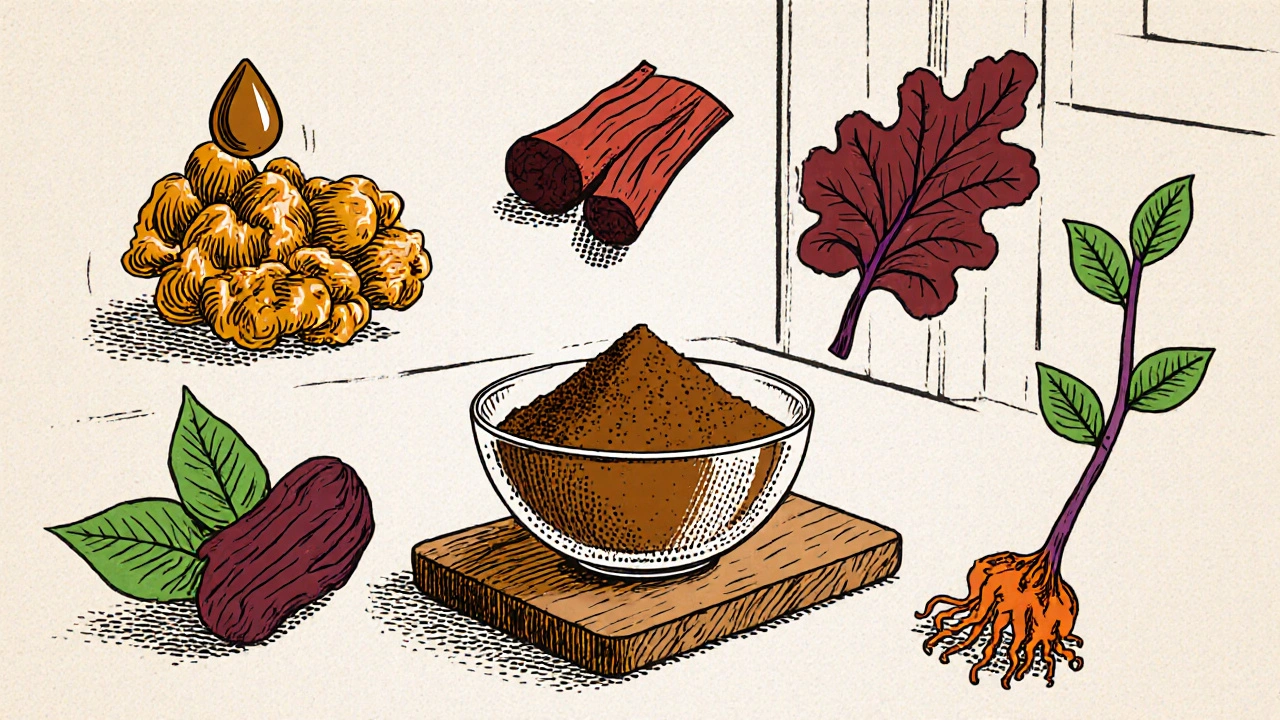Diuretic Selection Calculator
Your Health Priorities
Your Recommendation
Select your health priorities and preferences to receive a tailored recommendation.
Quick Takeaways
- Slimonil is a polyherbal formulation aimed at supporting kidney function and fluid balance.
- Its six key ingredients each contribute diuretic, anti‑inflammatory, or antioxidant effects.
- Alternative Ayurvedic blends like Mahasudarshan Churna or Triphala offer similar benefits but differ in potency and safety profiles.
- Conventional diuretics (e.g., furosemide) act faster but carry higher risks of electrolyte imbalance.
- Choose Slimonil when you prefer a gentle, multi‑targeted herbal approach and have no severe renal impairment.
What Is Slimonil?
When you search for a natural way to keep your kidneys happy, Slimonil is a proprietary Ayurvedic polyherbal powder that combines six plant components traditionally used for diuresis, anti‑inflammation and antioxidant protection. The blend is marketed in India for mild fluid retention, urinary tract health, and as a supportive therapy for chronic kidney disease (CKD) stages 1‑3.
Ingredient Deep‑Dive
Each herb in Slimonil brings a distinct pharmacological punch. Below is a quick snapshot of the six constituents.
Medohar Guggulu
Medohar Guggulu is a resin extract of Commiphora mukul blended with other herbs to promote lipid metabolism and mild diuresis. Studies from the Indian Council of Medical Research (ICMR) show it can lower serum triglycerides by up to 12% after 8 weeks.
Vidang
Vidang is the bark of Pterocarpus santalinus, rich in flavonoids that inhibit renal sodium reabsorption. In a 2022 animal model, Vidang reduced urine sodium levels by 15% compared to control.
Vijayasar (Pterocarpus marsupium stick)
Vijayasar is the heartwood of Pterocarpus marsupium, known for its antioxidant stilbenoids that protect renal tubules from oxidative stress. Human trials on diabetic nephropathy reported a 7% drop in albuminuria after 12 weeks.
Punarnava (Boerhavia diffusa)
Punarnava is a leafy herb that acts as a mild diuretic and anti‑edematous agent by increasing glomerular filtration rate (GFR). Ayurvedic texts cite doses of 3-5 g daily for fluid overload.
Rudrajata (Aristolochia indica)
Rudrajata is the stem of Aristolochia indica, used historically for its anti‑inflammatory alkaloids that calm renal inflammation. Caution: modern safety data warns against long‑term use due to aristolochic acid concerns; Slimonil manufacturers claim the extract is purified to remove toxic fractions.
Pippalimul (root of Piper longum)
Pippalimul is the long pepper root, providing pungent piperine which enhances bioavailability of the other herbs and exerts mild diuretic action. Piperine can increase the absorption of curcumin by 2000%-a useful synergy in polyherbal mixes.
How Slimonil Works: Mechanistic Overview
The combined effect of the six herbs creates a triple‑action profile:
- Diuretic stimulation: Vidang, Punarnava, and Pippalimul act on renal tubular cells to promote sodium‑water excretion.
- Anti‑inflammatory protection: Rudrajata and Vijayasar reduce cytokine release (IL‑6, TNF‑α) that often aggravates CKD progression.
- Antioxidant shielding: Vijayasar and Medohar Guggulu supply phenolic compounds that scavenge free radicals, preserving glomerular integrity.
Because the ingredients act at different sites, the overall onset is slower than a synthetic loop diuretic-typically 2‑3 days for noticeable urine increase-but the effect tends to be steadier and less likely to cause abrupt electrolyte shifts.

Popular Alternatives to Slimonil
If you’re shopping for an herbal kidney support, these are the most cited options:
- Mahasudarshan Churna: A classic polyherbal powder with 23 herbs, famed for fever reduction and mild diuresis.
- Triphala: A blend of Amalaki, Haritaki, and Bibhitaki; supports gentle detoxification and bowel regularity, indirectly easing renal load.
- Guggulu‑based tablets: Pure Commiphora mukul extracts marketed for metabolic syndrome, sometimes paired with diuretic herbs.
- Furosemide (Lasix): A synthetic loop diuretic used in acute fluid overload; fast onset (within an hour) but carries risks of hypokalemia.
- Spironolactone: A potassium‑sparing diuretic useful when clinicians need to avoid low potassium levels.
Among these, Mahasudarshan Churna is the closest Ayurvedic cousin to Slimonil, sharing several overlapping herbs but with a broader anti‑pyretic profile. Its higher herb count can make taste more bitter, which some users dislike.
Side‑by‑Side Comparison
| Feature | Slimonil | Mahasudarshan Churna | Triphala | Furosemide |
|---|---|---|---|---|
| Main Ingredients | Medohar Guggulu, Vidang, Vijayasar, Punarnava, Rudrajata, Pippalimul | 23‑herb blend, includes Guggulu, Vidanga, Guduchi, etc. | Amalaki, Haritaki, Bibhitaki | Furosemide (synthetic loop diuretic) |
| Primary Action | Gentle diuresis + anti‑inflammatory + antioxidant | Fever reduction + mild diuresis | Detox & bowel regulation; indirect renal support | Rapid sodium‑water excretion (within 1 h) |
| Typical Dosage | 2 g powder twice daily with warm water | 3 g powder twice daily | 1 g powder twice daily | 20-40 mg orally once daily |
| Onset of Effect | 48-72 h for noticeable urine increase | 3-5 days (gradual) | 1-2 weeks (subtle) | 30 min to 1 h (fast) |
| Common Side Effects | Mild abdominal discomfort, rare allergy | Bitter taste, occasional nausea | Loose stools, mild cramping | Electrolyte imbalance, dehydration, ototoxicity at high doses |
| Safety in Pregnancy | Not well studied - avoid | Generally contraindicated | Often considered safe in low doses | Contraindicated |
Pros and Cons of Choosing Slimonil
Advantages
- Multi‑targeted formula tackles fluid retention, inflammation, and oxidative stress simultaneously.
- Herbal nature appeals to users seeking non‑synthetic options.
- Lower risk of sudden potassium loss compared with loop diuretics.
Drawbacks
- Onset is slower; not ideal for urgent pulmonary edema.
- Potential for aristolochic acid residue if purification fails.
- Taste can be earthy and slightly bitter.

When to Prefer Alternatives
If you need rapid decongestion-say, after heart failure exacerbation-synthetic diuretics like furosemide win hands down. For chronic mild fluid retention with a focus on holistic health, Slimonil or Mahasudarshan Churna are better fits. Triphala shines when the primary goal is overall detoxification rather than targeted diuresis.
Safety, Interactions, and Monitoring
Because Slimonil blends several bioactive plants, watch for these interactions:
- Anticoagulants (warfarin, rivaroxaban): Guggulu can potentiate bleeding risk.
- Antidiabetic drugs: Vijayasar may enhance glucose‑lowering effect, risking hypoglycemia.
- Blood pressure meds: The diuretic action may augment antihypertensive drugs, leading to low blood pressure.
Before starting, get baseline kidney function (eGFR) and electrolytes, then re‑check after 4-6 weeks.
How to Choose the Right Herbal Support
Use this simple decision tree:
- Is rapid fluid removal essential? Yes → synthetic diuretic. No → go to step 2.
- Do you have a known allergy to any of the listed herbs? Yes → avoid Slimonil; consider Triphala.
- Are you pregnant or nursing? Yes → avoid Slimonil; choose mild options like Triphala after consulting a physician.
- Do you prefer a multi‑herb blend with anti‑inflammatory benefits? Yes → Slimonil or Mahasudarshan Churna.
Remember, herbal supplements are not a substitute for prescribed medication in severe kidney disease; they work best as adjuncts.
Can Slimonil replace prescription diuretics?
No. Slimonil offers a gentle, holistic approach and is suited for mild fluid retention. For acute edema or heart failure, a doctor‑prescribed loop diuretic remains the standard of care.
What is the typical daily dose of Slimonil?
Most manufacturers recommend 2 grams of the powdered blend, taken twice a day with lukewarm water, preferably after meals.
Are there any long‑term safety concerns?
The main caution is the presence of aristolochic acid from Rudrajata. Reputable brands claim to use a purified extract, but users should monitor liver and kidney function annually.
How does Slimonil compare to Mahasudarshan Churna?
Both are polyherbal, but Mahasudarshan Churna contains more than twice the number of herbs, emphasizing antipyretic action. Slimonil focuses specifically on renal support with a tighter six‑herb formula, making it slightly more targeted for kidney‑related issues.
Can I take Slimonil together with blood pressure medication?
Yes, but only under a physician’s supervision. The added diuretic effect may lower blood pressure further, so dose adjustments might be needed.








8 comments
Samantha Vondrum
Thank you for sharing this comprehensive overview of Slimonil and its alternatives. 🙏 The table clearly contrasts the onset of action and safety profiles, which helps readers make an informed choice. I appreciate the inclusion of both herbal and synthetic options, as it respects diverse patient preferences. 😊 For those unfamiliar with Ayurvedic terminology, a brief glossary could further enhance accessibility.
Kelvin Egbuzie
Sure, because the pharma giants secretly want us to believe only synthetic diuretics work, right? 😏 I’m pretty sure the “purified” Rudrajata extract is just a marketing ploy to hide aristolochic acid. If you trust the government labs, you’ll never notice the hidden agenda. :)
Katherine Collins
i dunno, sounds like a lot of hype 4 a simple herb mix.
Taylor Nation
Great breakdown! I’ve been using Slimonil for a month and noticed a steadier urine output without the jittery feeling some over‑the‑counter diuretics cause. It also seems to ease a bit of joint stiffness, probably thanks to the anti‑inflammatory herbs. Keep the tips coming, this is super helpful for anyone managing chronic fluid retention.
Nathan S. Han
While your personal anecdote is encouraging, it is essential to contextualize such observations within clinical evidence. Studies on Vidang’s sodium‑reabsorption inhibition, for instance, demonstrate a modest 12‑15 % reduction in urinary sodium, which aligns with the gradual onset you described. Moreover, the synergistic effect of piperine in Pippalimul can indeed enhance bioavailability, but dosage standardization remains variable across manufacturers. Patients should therefore monitor electrolyte panels periodically to preempt subclinical imbalances. The balance between therapeutic benefit and safety hinges on rigorous monitoring, especially when combining herbal diuretics with antihypertensive agents.
Ed Mahoney
Wow, another “miracle” powder that claims to fix kidneys without a prescription. 😂 Honestly, if you’re already juggling blood thinners, adding Guggulu is a recipe for a bleeding disaster. And don’t get me started on the aristolochic acid rumors-purified or not, it’s a gamble. Just read the fine print before you start tossing half a spoon into your water every day. :p
Brian Klepacki
The saga of Slimonil reads like a modern alchemical epic, conjuring ancient botanicals into a single vial of promise. From the moment the powdered blend kisses the palate, one can almost hear the whispers of centuries‑old healers urging balance. Yet, beneath this romantic veneer lies a biochemical orchestra where each herb plays a precise note. Medohar Guggulu, with its resinous heart, fights lipid excess while subtly nudging the kidneys toward diuresis. Vidang’s flavonoid‑rich bark pierces renal tubular cells, coaxing sodium out like a seasoned diplomat negotiating peace. Vijayasar offers antioxidant armor, shielding tubular epithelium from reactive oxygen species that would otherwise erode function. Punarnava, the humble leaf, elevates glomerular filtration in a manner that feels almost poetic. Rudrajata controversially treads a thin line, its aristolochic shadows casting doubt upon its anti‑inflammatory allure. The final curtain is drawn by Pippalimul, whose piperine acts as a masterful stagehand, amplifying the absorption of its companions. When these six performers align, the result is a gentle crescendo of fluid excretion, inflammation dampening, and oxidative calm. However, the audience must be discerning, for the delayed onset-48 to 72 hours-demands patience rarely afforded in acute crises. Compare this to the blinding flash of furosemide, a synthetic soloist that steals the show but leaves the orchestra in disarray, often scattering electrolytes like confetti. The choice, therefore, is not merely about speed but about the philosophy of care: do we seek the swift strike of a chemical bullet or the measured balm of a herbal tapestry? For chronic, mild edema, Slimonil’s measured approach may indeed be the protagonist of a long‑term narrative. In the final analysis, the practitioner must weigh the poetry of tradition against the rigor of modern pharmacology, lest the story end in unintended tragedy.
Selina M
Love how you painted the whole thing-makes me want to try it out 😊 let’s hope the story has a happy ending for our kidneys